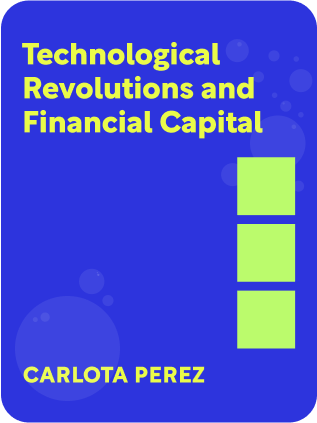

This article is an excerpt from the Shortform book guide to "Technological Revolutions and Financial Capital" by Carlota Perez. Shortform has the world's best summaries and analyses of books you should be reading.
Like this article? Sign up for a free trial here .
What are the four stages of an industrial revolution? How do they lead to technological revolutions?
The four stages of an industrial revolution include everything from market disruption to maturity and change in the revolution. Each stage is important for creating an industrial revolution that changes the world.
Read more about the four stages of an industrial revolution and why they matter.
The Four Stages of an Industrial Revolution
There are four stages of an industrial revolution. At a high level, the four phases of an industrial revolution look as follows:
- Installation period
- Phase 1: Irruption: A new promising technology sees explosive growth as venture capitalists, seeking high profits, invest in new activities and firms.
- Phase 2: Frenzy: Investments reach irrational exuberance level, as investors become excited about the profit possibilities of the new technology.
- Turning Point
- Many early expectations will be disappointed, leading to collapse of bubbles created by financial speculation in the industrial revolution stages.
- However, the boom from the Installation period installs the infrastructure that paves the way for…
- Deployment period
- Phase 3: Synergy: A robust growth occurs, built on the infrastructure of installation. The technology becomes widely adopted across the economy and leads to fundamental growth in a “new economy.”
- Phase 4: Maturity: The technology sees diminishing returns. The main companies have merged and become oligopolies, reducing the ferocity of competition and a common interest in comfortable profit margins. Arthritis sets in for the new incumbents .
- Attention shifts to the next generation of radical innovations, thus continuing the cycle
All four phases of an industrial revolution are necessary and important to the technological revolution.
In the next chapters, we’ll dig further into each phase, covering the technological, social, and financial aspects in the four phases of an industrial evolution.
Financial Capital vs Production Capital
In Technological Revolutions, when Carlota Perez uses the term “capital,” she refers not to the actual capital (money), but rather to the agents and their motives in wealth creation in the industrial revolution stages. Tread about the four stages of an industrial revolution below.
Financial capital represents the agents who possess wealth in the form of money or relatively liquid assets. Their objective is to make money from money, and they perform actions that are most likely to increase their wealth. Financial capital reallocates and redistributes wealth.
Production capital represents the agents who generate new wealth by producing goods or services. These agents do this with borrowed money from financial capital and share the generated wealth. Their desire is to accumulate greater profit-making capacity by innovating, growing, and expanding. These properties are all important to consider with the four stages of an industrial revolution.
As we’ll see, both financial capital and production capital have critical roles to play in the arc of the industrial revolution stages.
Financial capital and production capital are different by nature:
- Financial capital is mobile by nature, while production capital is tied to concrete products.
- Financial capital can invest in a firm without much knowledge of what it does. For production capital, knowledge about product and markets is the very foundation of success.
- Financial capital is footloose by nature and will flee danger, while production capital has to face every storm or perish.
- Ironically, as a revolution matures, incumbent production capital can become conservative and unreceptive to innovation. In this stage, it is the role of financial capital to enable the rise of new entrepreneurs.
The stages of industrial revolution help explain how these revolutions happen, and why they take place. Keep in mind that all four phases of an industrial revolution have to occur in order for it to be truly a technological revolution.

———End of Preview———
Like what you just read? Read the rest of the world's best book summary and analysis of Carlota Perez's "Technological Revolutions and Financial Capital" at Shortform .
Here's what you'll find in our full Technological Revolutions and Financial Capital summary :
- What happened during the 2000 tech bubble and the 2002 crash
- The 5 technological revolutions that reshaped society since 1771
- How you might be able to predict and prepare for the next technological revolution






